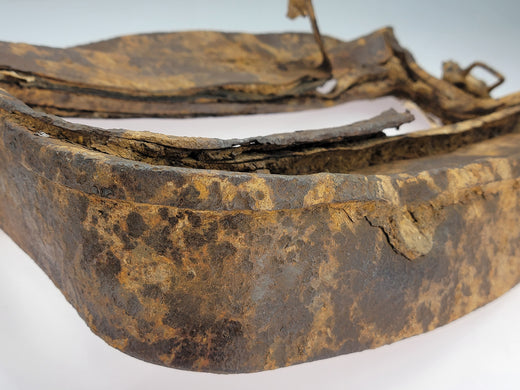This Fine Art Print by Artist Craig Tinder illustrates Shermans of the British 11th Armoured Division gaining the upperhand over units of Germany's 2nd Panzer Division during Operation Bluecoat. This Limited Edition Canvas Print includes a piece of steel from a British 11th Amoured Division Sherman Tank.
Details About the RELIC:
Displayed on a metallic dataplate, this steel fragment was taken from a larger internal metal latch cover from a Sherman tank of the 11th Armoured Division. Discovered near the village of Habloville, France, this internal latch cover still includes the frozen clasps and original gasket. With faint traces of green paint still appearing on the edges, this latch cover includes small fragments of canvas cloth that once covered the top. Typically, canvas rarely lasts more than a few years when buried, so this relic definitely retains more originality than other armour fragments we've worked with.
The shape of the cover is highly distorted from the damage this tank sustained during fighting at the Falaise Pocket on 16-20 August 1944. It is one of the few armour relics that can be processed for inclusion in relic art given the large, heavy size of tank armor.
 Steel fragment from metal latch cover of Sherman Tank. Pieces of this are used as the relics in the "Operation Bluecoat" limited edition prints
Steel fragment from metal latch cover of Sherman Tank. Pieces of this are used as the relics in the "Operation Bluecoat" limited edition prints
 Steel fragment from metal latch cover of Sherman Tank. Pieces of this are used as the relics in the "Operation Bluecoat" limited edition prints
Steel fragment from metal latch cover of Sherman Tank. Pieces of this are used as the relics in the "Operation Bluecoat" limited edition prints
 Steel fragment from metal latch cover of Sherman Tank
Steel fragment from metal latch cover of Sherman Tank
 Artist, Craig Tinder, holding fragment of internal metal latch cover from Sherman Tank that is used as the relics in the "Operation Bluecoat" limited edition prints
Artist, Craig Tinder, holding fragment of internal metal latch cover from Sherman Tank that is used as the relics in the "Operation Bluecoat" limited edition prints
The Story Behind the Print:
The artwork depicting the 11th Armoured Division and their Sherman Fireflies during the Falaise Pocket in August 1944 showcases one of the most critical moments of the Allied breakout in Normandy. During Operation Bluecoat, the 23rd Hussars, part of the 29th Armoured Brigade of the 11th Armoured Division, engaged elements of the 2nd Panzer Division as they pushed through German lines. After successfully capturing a crucial bridge over the River Souleuvre near Bény-Bocage, the 23rd Hussars exploited the surrounding high ground, gaining a tactical advantage against the German forces. Their actions in securing this area were vital to the success of the operation.
The Sherman Firefly, equipped with a powerful 17-pounder gun, played a key role in combating German tanks during this operation. In particular, the Fireflies were instrumental in neutralizing the heavily armored German Panzer units, including the formidable Tiger and Panther tanks. The Fireflies of the 23rd Hussars not only provided fire support but also enabled the division to take and hold key positions during their advance. The relentless push by the 11th Armoured Division was essential in keeping the pressure on the retreating German forces and closing the Falaise Pocket.
After enemy resistance began to dwindle, the 23rd Hussars advanced into the nearby town of La Ferrière-Harang, where they were met not with gunfire, but with jubilant crowds. The local population, overjoyed by their liberation from German occupation, greeted the soldiers of the 23rd Hussars with a spontaneous celebration, marking the transition from fierce combat to liberation. This moment symbolized both the tactical success of the Allies and the emotional impact of freeing towns that had suffered under occupation.
Learn more about A Potent Variant of an Iconic Tank in Sherman Firefly? Click Here
To purchase or see similar items, visit here.
Commissioned by Museums, Treasured by Collectors





Share:
Tuskegee Triumph, the story behind "In Support of Varsity"
America's FIRST Ace, the story behind "The First Victory"